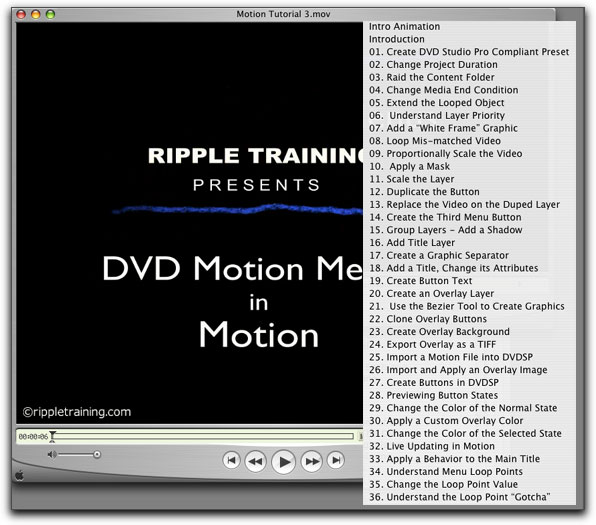Back when Final Cut Pro was still a new
NLE, there was very little out there in terms of tutorials and
books. Steve Martin began working with the DV GUYs website developing
QuickTime tutorials you could download, use and learn from. Many
of those tutorials are still up on that website and Steve's own
Ripple Training site. Point is, Steve has been at this for a
long time as one of the leading teachers of all things Apple.
It stands to reason that he would produce some incredible tutorials
for the Motion program and he has.
Focusing on the integration of
Motion and DVD Studio Pro, Steve takes you through the entire
process of creating DVD menus in Motion, utilizing clips supplied
with the tutorial, right on through bringing the Motion created
menu into DVD Studio Pro, creating the buttons and activating
them for your DVD project. No fuss, no bother, and no necessity
of going through the tedious process of creating everything in
Photoshop. Everything worked easily and seamlessly.
Steve's tutorial starts off with
the basic setup of the Motion project itself, spending just the
right amount of time on setting the proper project preferences
before diving into the DVD Motion Menu creation itself. Within
Motion he takes you from dragging the background picture frames
from the Motion library, which will serve as drop shadowed surrounds
for the Menu buttons themselves once easily integrated within
DVD Studio Pro. It was a simply process to drag the frames to
the canvas and then utilizing the keyboard shortcuts supplied
in the tutorial, create a mask and two more buttons off the first
one. Very simple. From there you move to create masks and scale
each of the buttons to proper size before adding the drop shadows,
graphic separation bars, color adjustment, text, behaviors and
a clone overlay layer. This final Motion work is what will then
be effortlessly integrated with your DVD SP project.

Creating
the highlight-able buttons via simple use of the bezier tool
you can, of course, make any shape you want.

The
buttons have been created, duplicated and the Menu is now ready
to be brought easily into DVD Studio Pro.

The
Motion created menu has now been brought into DVD Studio Pro.
We are ready to set up and activate the buttons.
Once things have all been exported and set up in DVD SP, Steve
even guides you back to Motion to make certain changes, and then
seamlessly brings you back to SP to further illustrate the very
real ease of the entire process. This I did by going back to
Final Cut Pro, exporting some of my own footage into the Motion
buttons project, changing text and seeing how easily Motion updated
these changes into DVD SP.

Activating
the DVD Studio Pro buttons.
The Motion Buttons Tutorial is an easy to use QuickTime download;
you can jump from segment to segment via the menu triangle on
the lower right hand side. There are 36 separate segments in
all, each, a next step in the tutorial process. The window is
easily scalable to fit any size you feel comfortable working
from.

While this tutorial succeeds in
its intended purpose, that of creating buttons in Motion to be
used in DVD SP, it actually goes considerably further. The user
is regularly provided with various keyboard shortcuts, workflow
and helpful hints that generate good habits and awareness of
the 'whys' of what you are doing. It is not enough that you can
follow the directions of the tutorial; it is far more important
in learning Motion, or any application, that you develop an understanding
of how it works and why you are taking the steps you are. All
learning is sequential, thus if you could not apply what you
learn in this tutorial to other independent projects, you would
gain little beyond its' initial scope. That point is moot however,
as every step, every short cut and every explanation given serves
a much wider purpose than the simple creation of buttons for
DVD SP. The skills demonstrated are ones that form the basis
for numerous future projects: they are useful, transferable and
foundational. One thing Steve does, which I don't think I have
seen before, is ask the person using the tutorial questions about
the steps they are about to make. This interrogatory approach
enables the user to think about what they are doing. This tutorial
is more than creating a project where one simply follows directions
without developing the clarity that should be gained. I would
encourage more authors of similar tutorials to try this same
strategy. The tutorial movie itself can be referred to as often
as necessary to remember particular functions and skills, long
after the first watching. Thus, it doubles as a kind of video
manual.
This is Steve Martin's third Motion
tutorial. I look forward to receiving any and all future Motion
videos that he may produce. Each one is an excellent substitute
for having him sitting beside you providing private lessons and
at one-tenth the cost. Beautifully done, humorous in many areas
and well worth the cost, you can't miss.
Available at Ripple
Training
Steve Douglas has been an underwater videographer and contributor to numerous
film festivals around the world. The winner of the 1999 Pacific
Coast Underwater Film Competition and the 2003 IVIE competition,
Steve has also worked on the feature film "The Deep Blue
Sea", recently contributed footage to the Seaworld parks
for their new Atlantis production, and is one of the principal
organizers of the San Diego UnderSea Film Exhibition. Steve leads
both African safari and underwater filming expeditions with upcoming
filming excursions to Thailand, Costa Rica, Kenya and Bali. Feel
free to contact
him if you are interested in joining him on these trips.
Review copyright ©
Steve Douglas 2004
This article
first appeared on www.kenstone.net and is reprinted here
with permission.
All screen captures and
textual references are the property and trademark of their creators/owners/publishers.